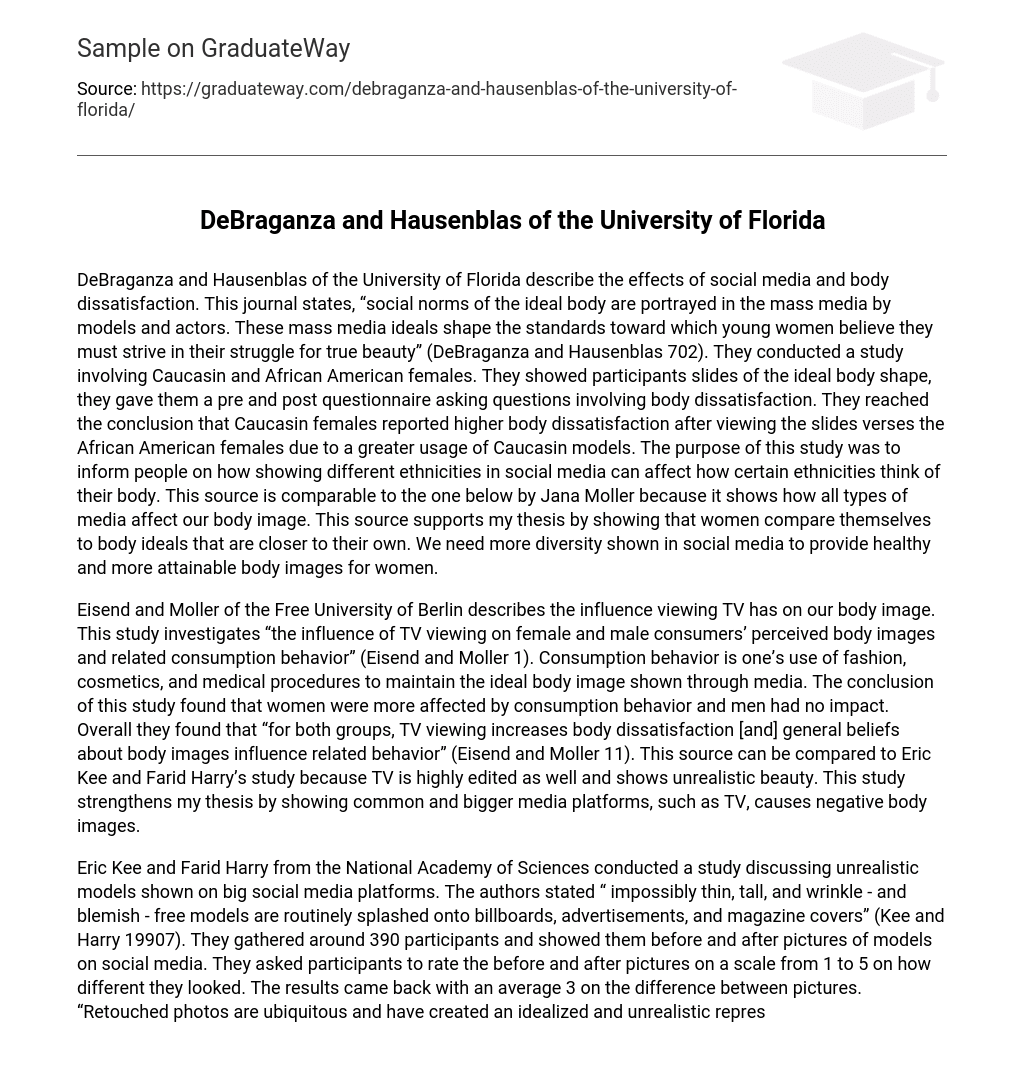DeBraganza and Hausenblas of the University of Florida describe the effects of social media and body dissatisfaction. This journal states, “social norms of the ideal body are portrayed in the mass media by models and actors. These mass media ideals shape the standards toward which young women believe they must strive in their struggle for true beauty” (DeBraganza and Hausenblas 702). They conducted a study involving Caucasin and African American females. They showed participants slides of the ideal body shape, they gave them a pre and post questionnaire asking questions involving body dissatisfaction. They reached the conclusion that Caucasin females reported higher body dissatisfaction after viewing the slides verses the African American females due to a greater usage of Caucasin models. The purpose of this study was to inform people on how showing different ethnicities in social media can affect how certain ethnicities think of their body. This source is comparable to the one below by Jana Moller because it shows how all types of media affect our body image. This source supports my thesis by showing that women compare themselves to body ideals that are closer to their own. We need more diversity shown in social media to provide healthy and more attainable body images for women.
Eisend and Moller of the Free University of Berlin describes the influence viewing TV has on our body image. This study investigates “the influence of TV viewing on female and male consumers’ perceived body images and related consumption behavior” (Eisend and Moller 1). Consumption behavior is one’s use of fashion, cosmetics, and medical procedures to maintain the ideal body image shown through media. The conclusion of this study found that women were more affected by consumption behavior and men had no impact. Overall they found that “for both groups, TV viewing increases body dissatisfaction [and] general beliefs about body images influence related behavior” (Eisend and Moller 11). This source can be compared to Eric Kee and Farid Harry’s study because TV is highly edited as well and shows unrealistic beauty. This study strengthens my thesis by showing common and bigger media platforms, such as TV, causes negative body images.
Eric Kee and Farid Harry from the National Academy of Sciences conducted a study discussing unrealistic models shown on big social media platforms. The authors stated “ impossibly thin, tall, and wrinkle – and blemish – free models are routinely splashed onto billboards, advertisements, and magazine covers” (Kee and Harry 19907). They gathered around 390 participants and showed them before and after pictures of models on social media. They asked participants to rate the before and after pictures on a scale from 1 to 5 on how different they looked. The results came back with an average 3 on the difference between pictures. “Retouched photos are ubiquitous and have created an idealized and unrealistic representation of physical beauty…The ubiquity of these unrealistic and highly idealized images has been linked to eating disorders and body image dissatisfaction in men, women, and children” (Kee and Harry 19910). This article can be compared to Dirk Smeester and Naomi Mandel’s study because of the negative impact edited pictures have on our self-esteem. The ability to edit photos and videos to make the models thinner is an evil and misleading part of social media. This source will help with my thesis by going into the unrealistic ways photos are retouched and how they are linked to eating disorders.
Dirk Smeester and Naomi Mandel of Arizona State University discussed the positive and negative impact social media has on one’s self. They conducted 2 experiments with female college students. They gave them a booklet of edited magazine pictures and had them rate those pictures on a scale of attractiveness and thinness. Then they did a mini assessment on their feelings after viewing these pictures. The results came back with some stating they had lower self-esteem and others stating they had a positive impact. One concern about this study is they used overweight and underweight models for their pictures, one might feel more positive about themselves after looking at pictures of overweight models so the results would be altered. One positive impact they found was, “an upward comparison target might also serve as an inspiration or role model” (Smeester and Mandel 577). This article can be compared to the first article because having more diversity with models has proved to have a more positive outlook on one’s self. With the information provided in this study I’ll be able to acknowledge and focus on the positive aspects of social media.





